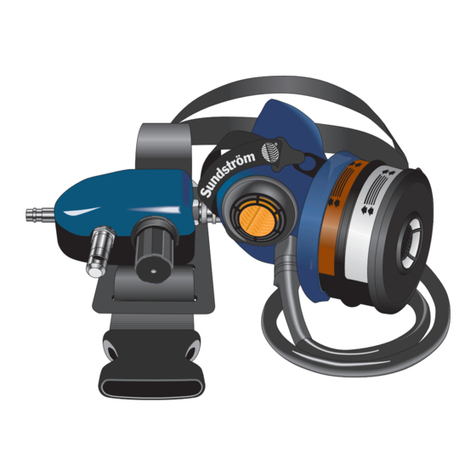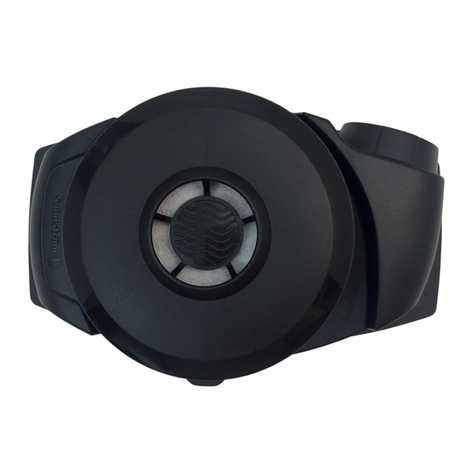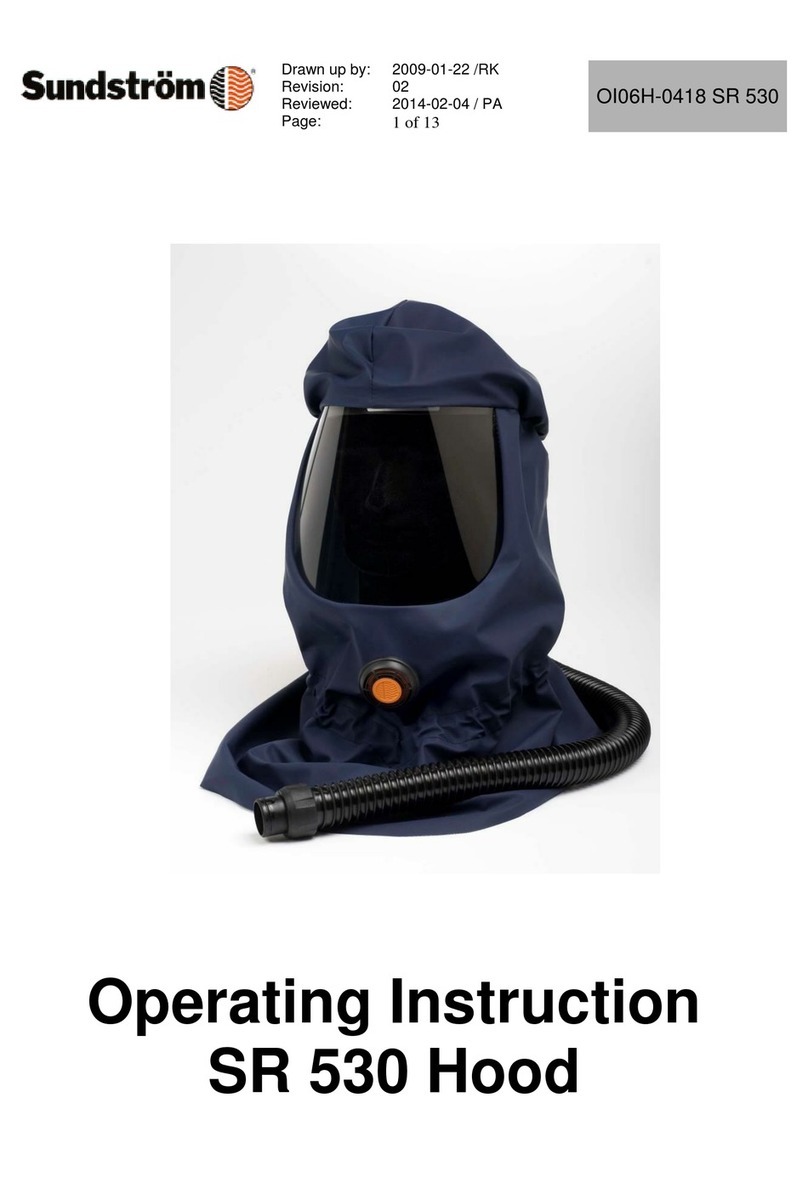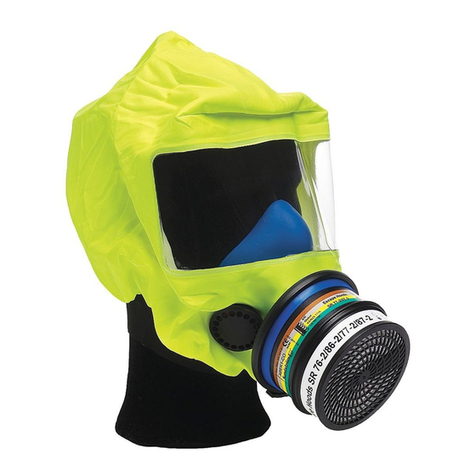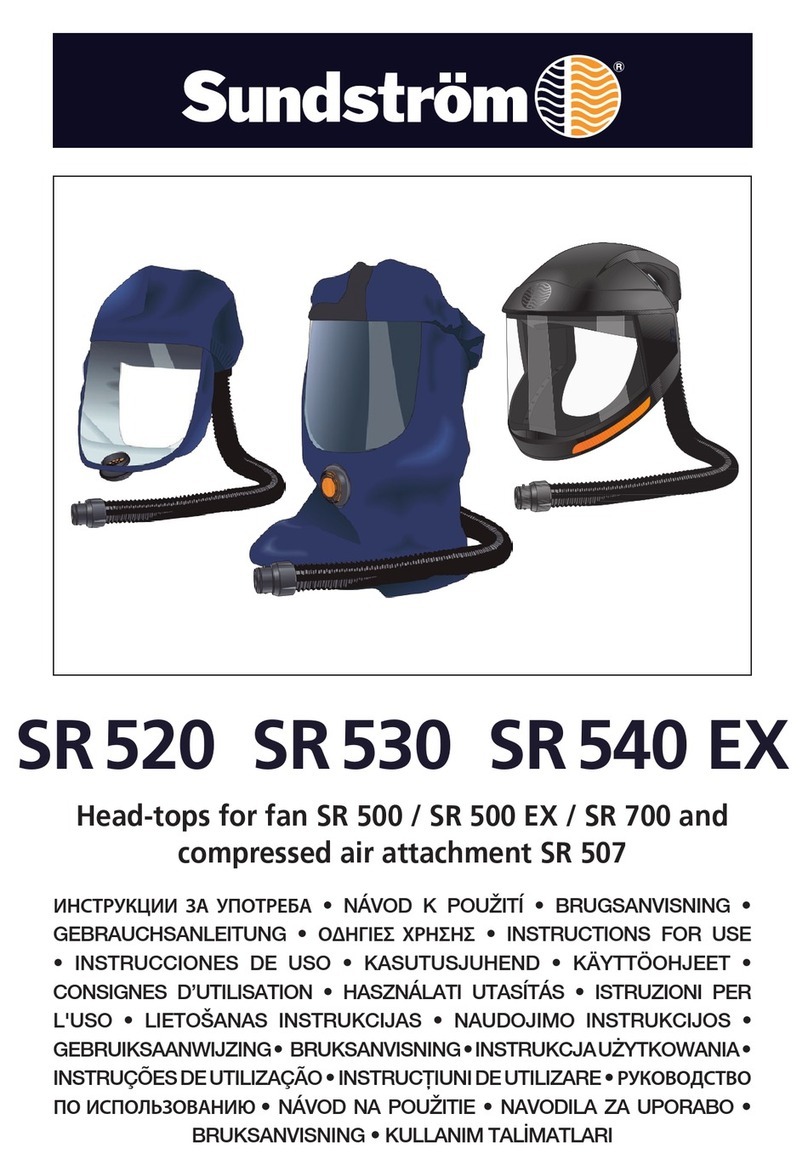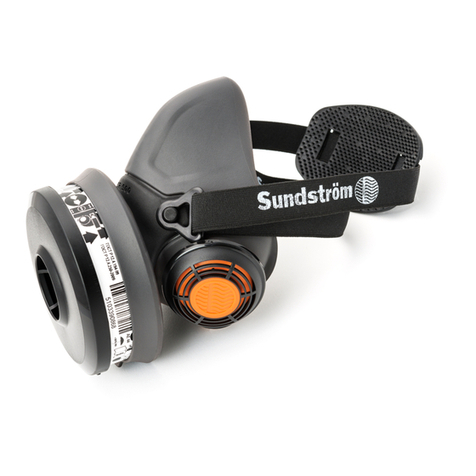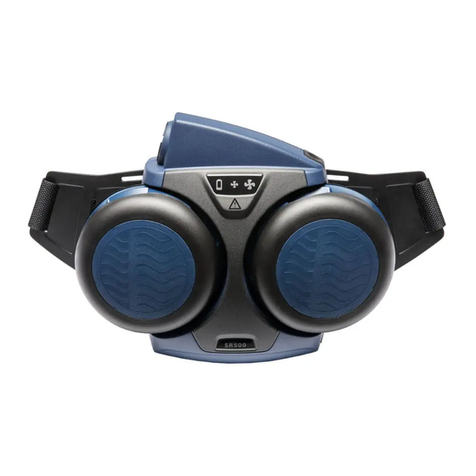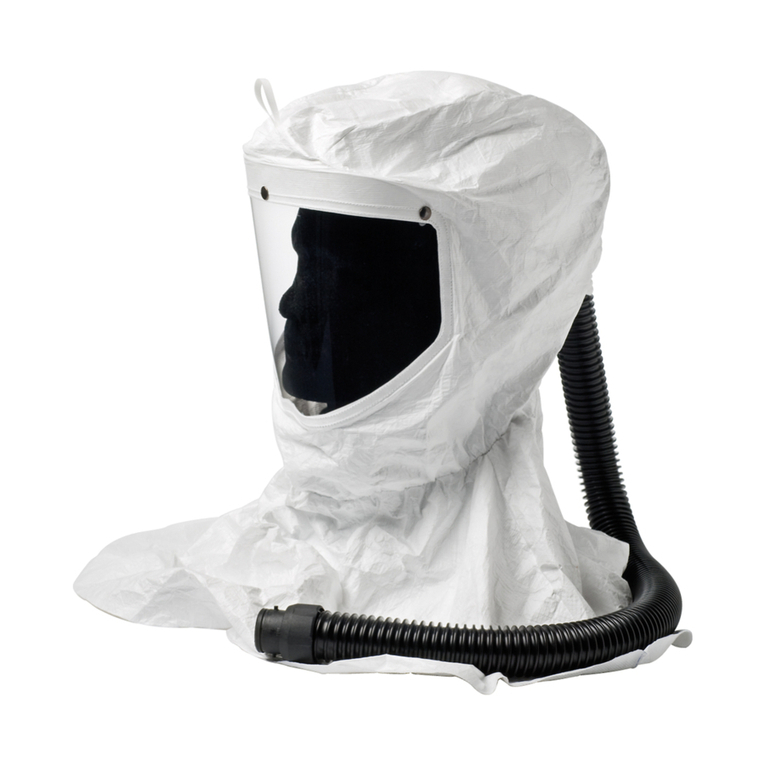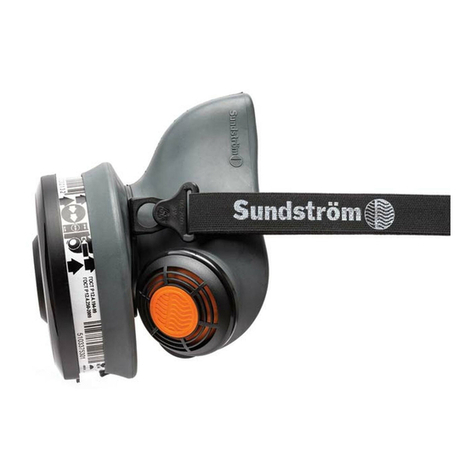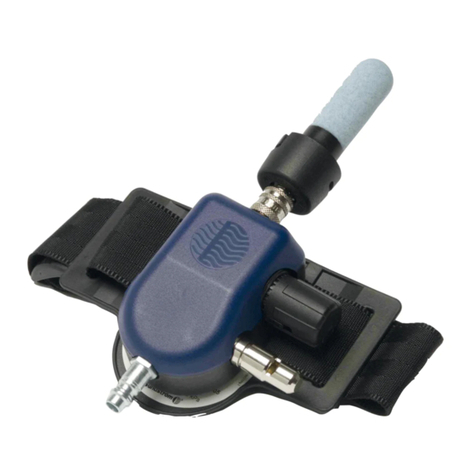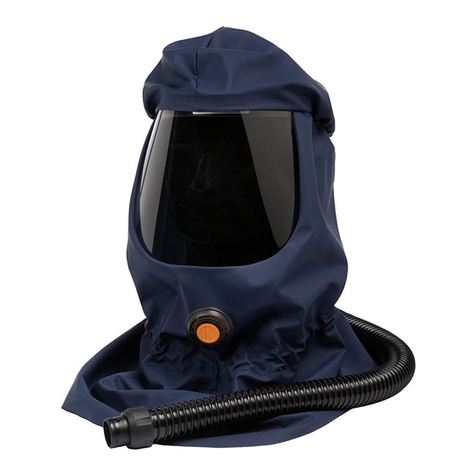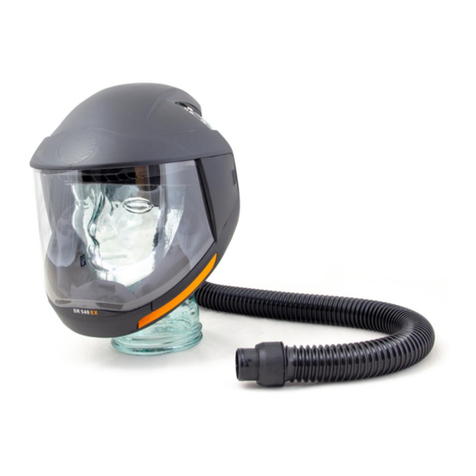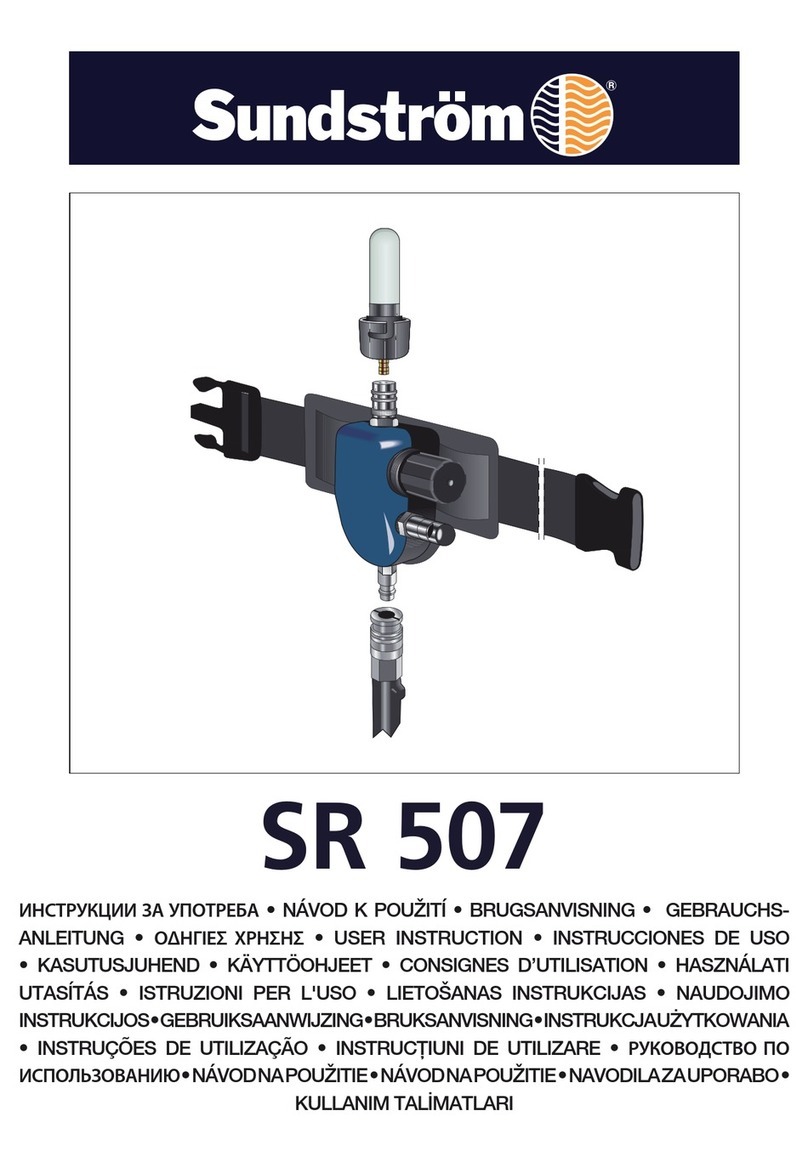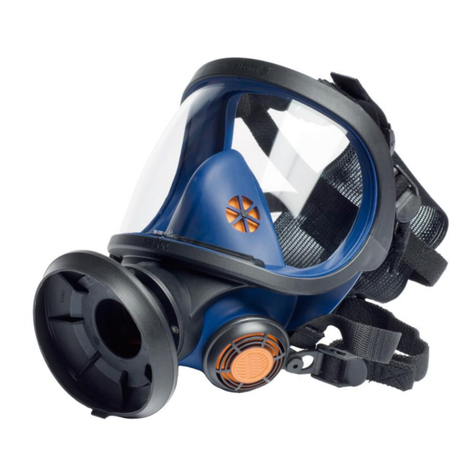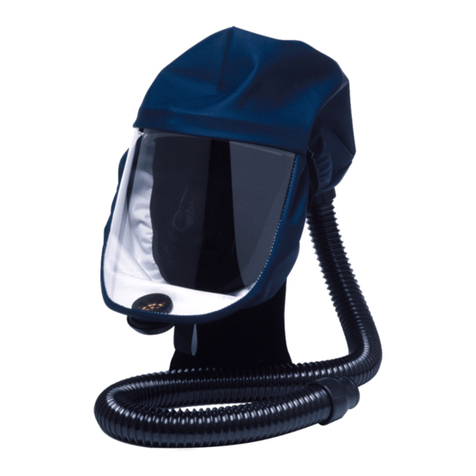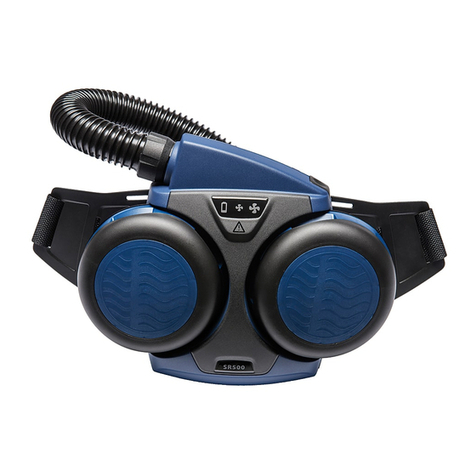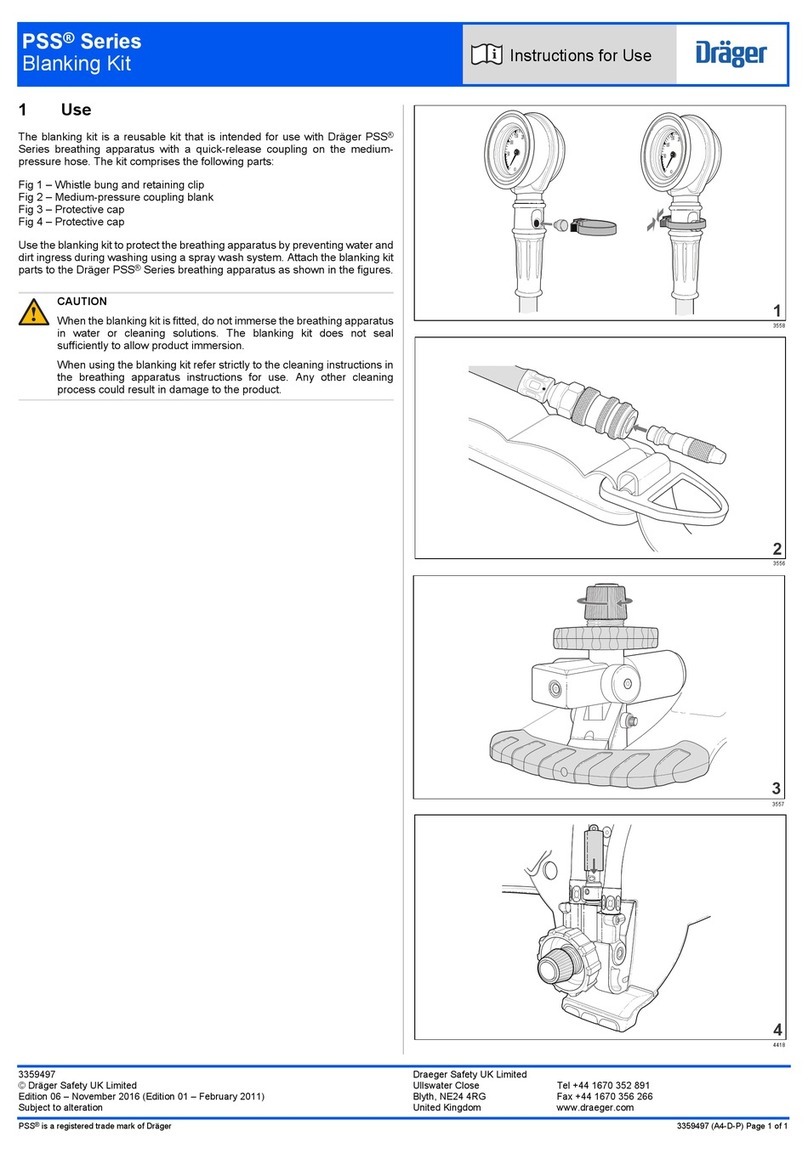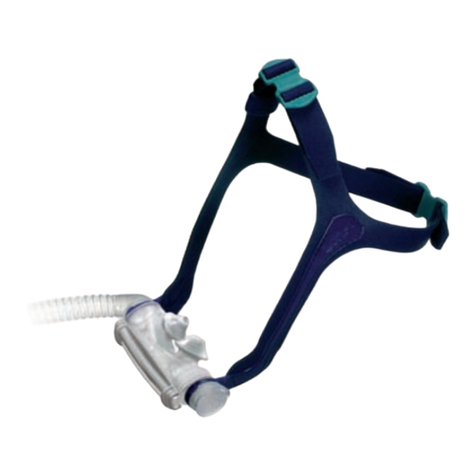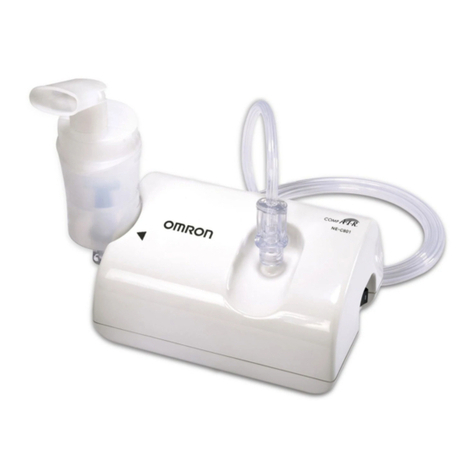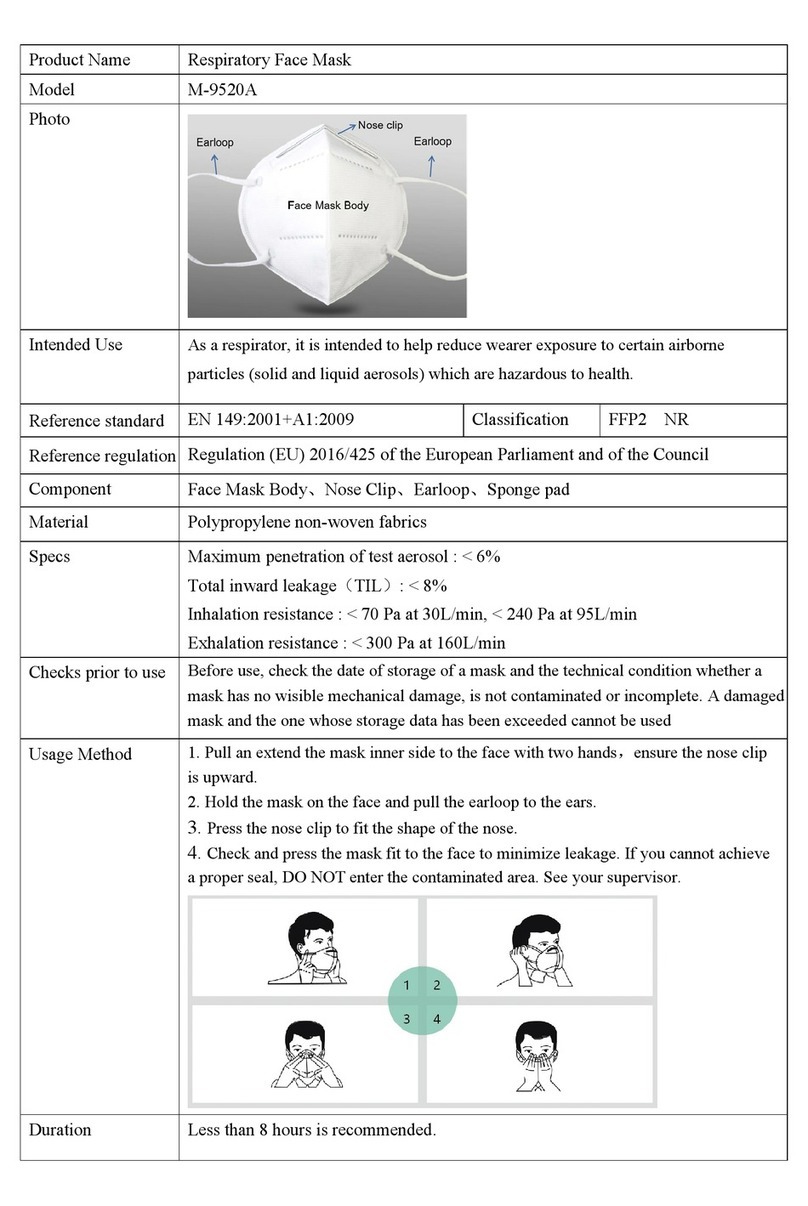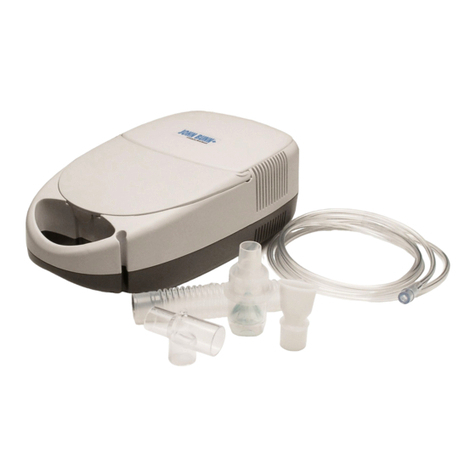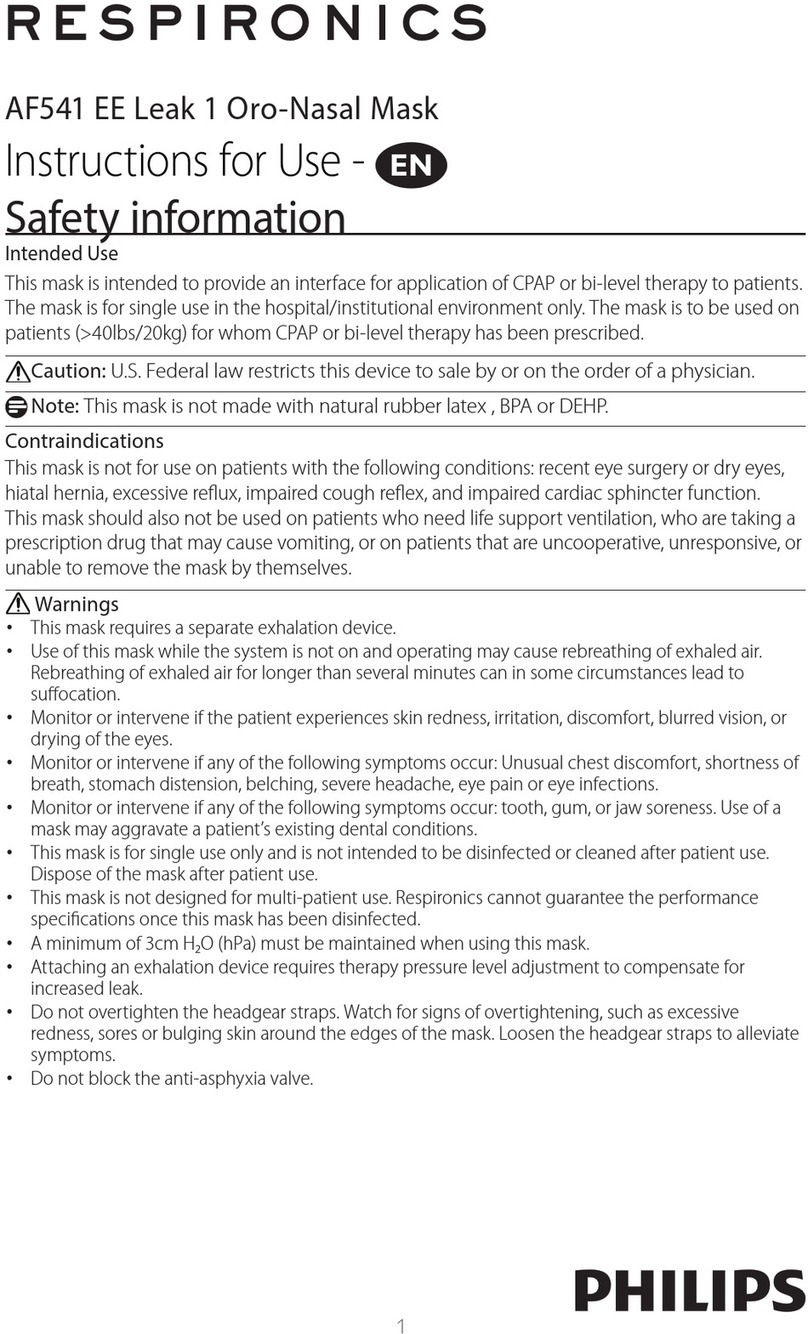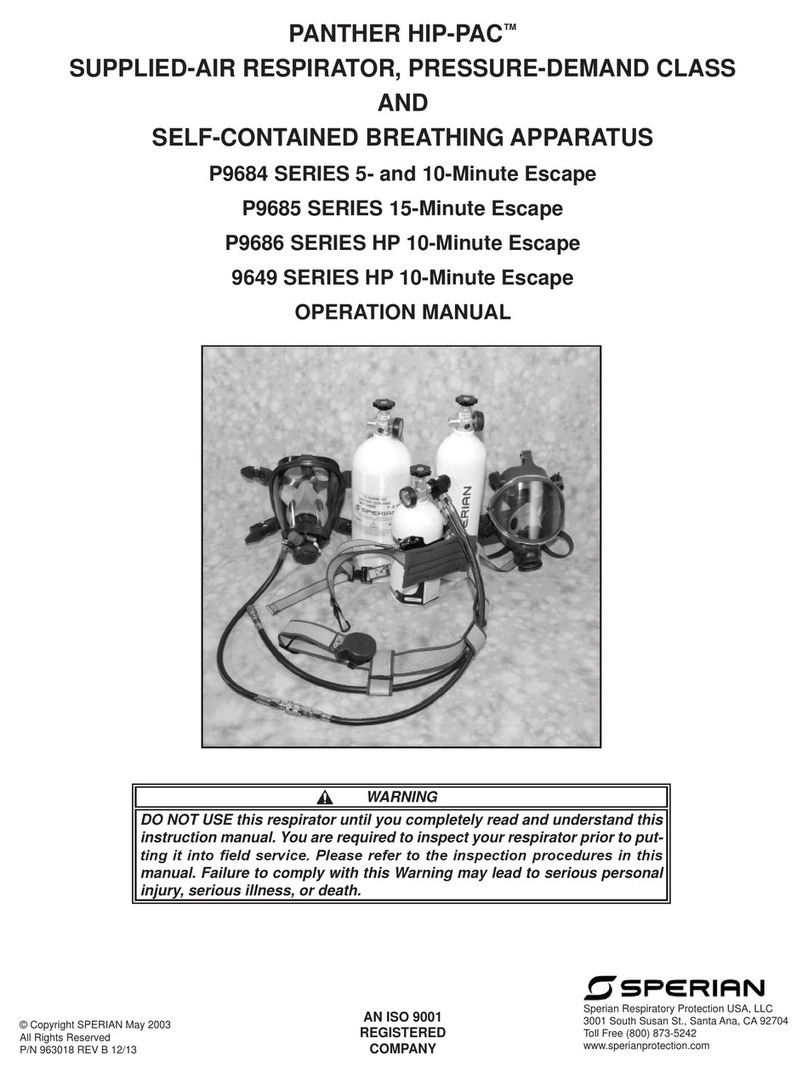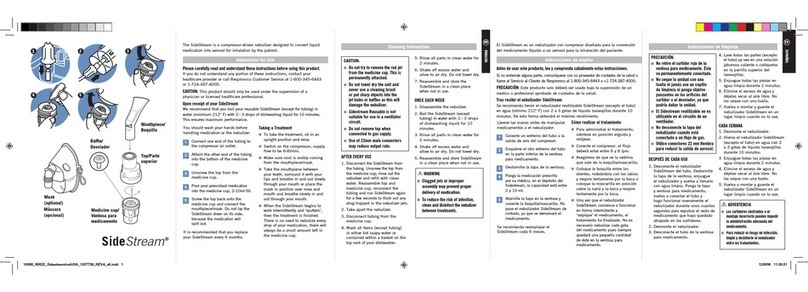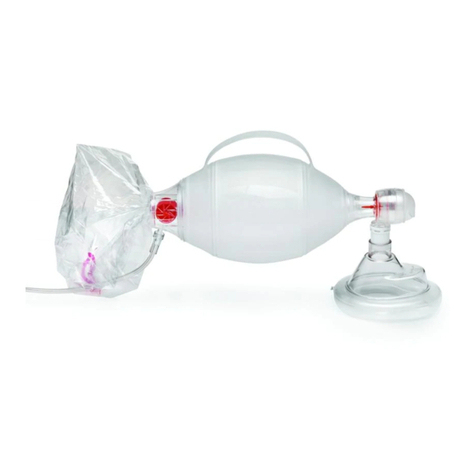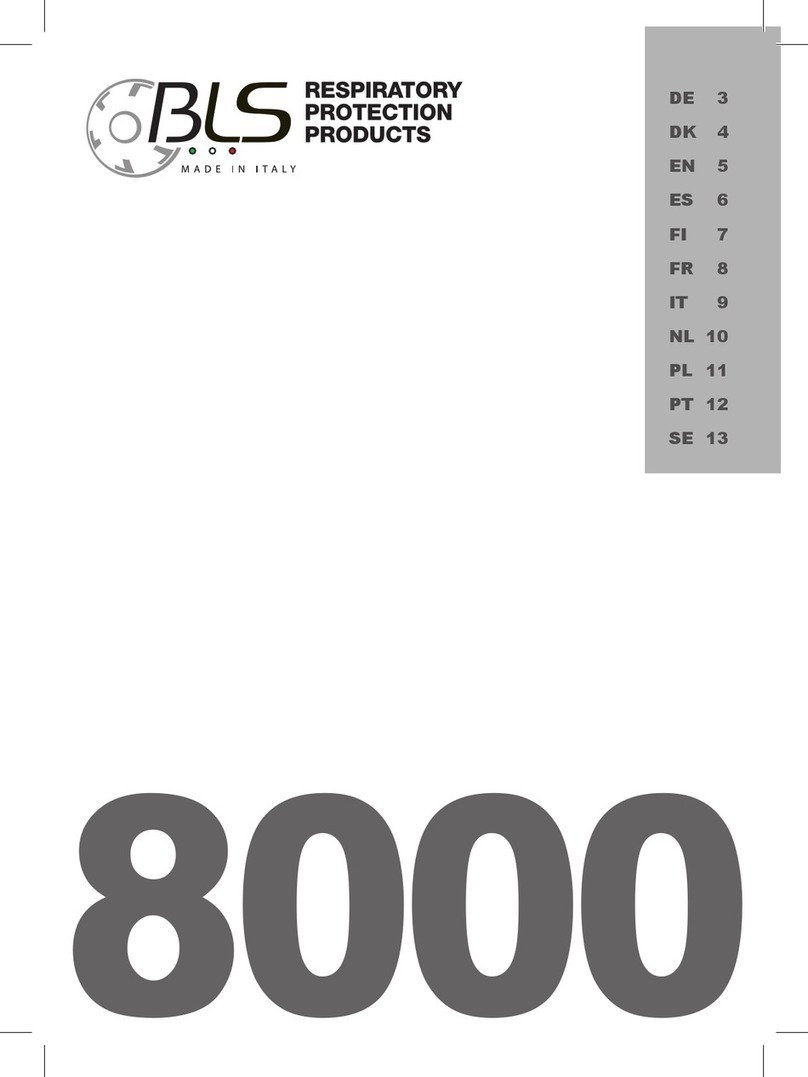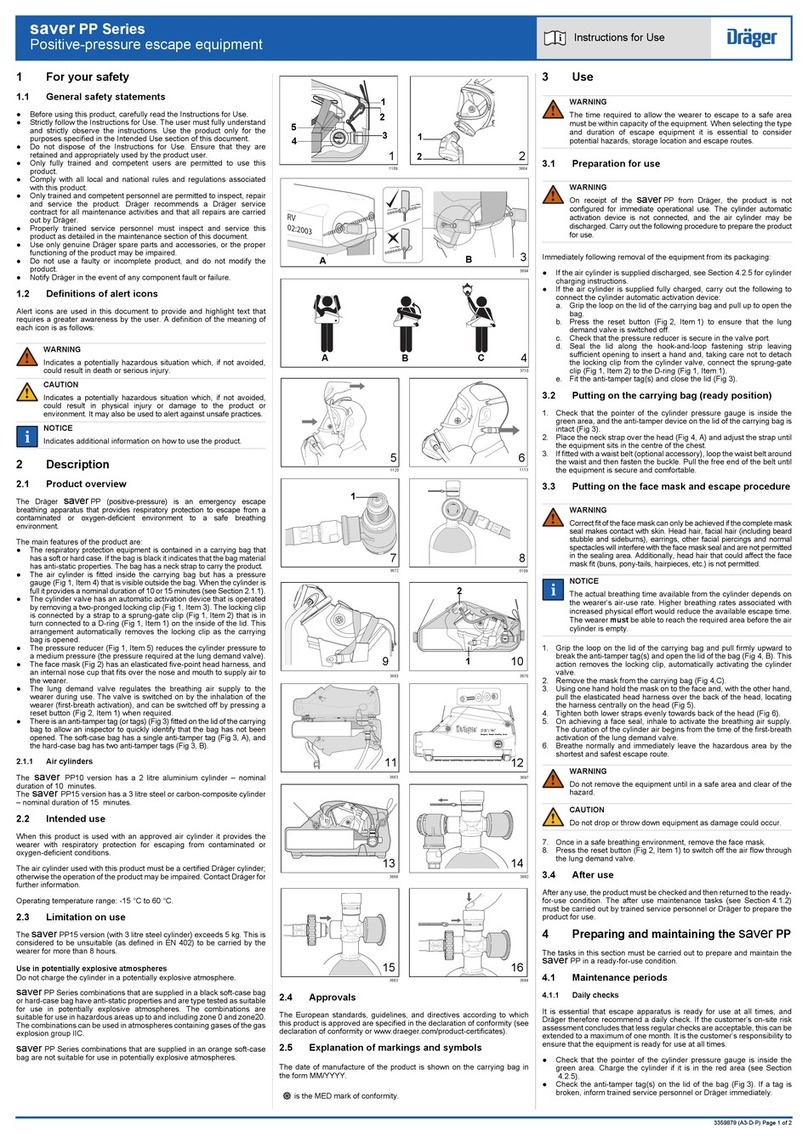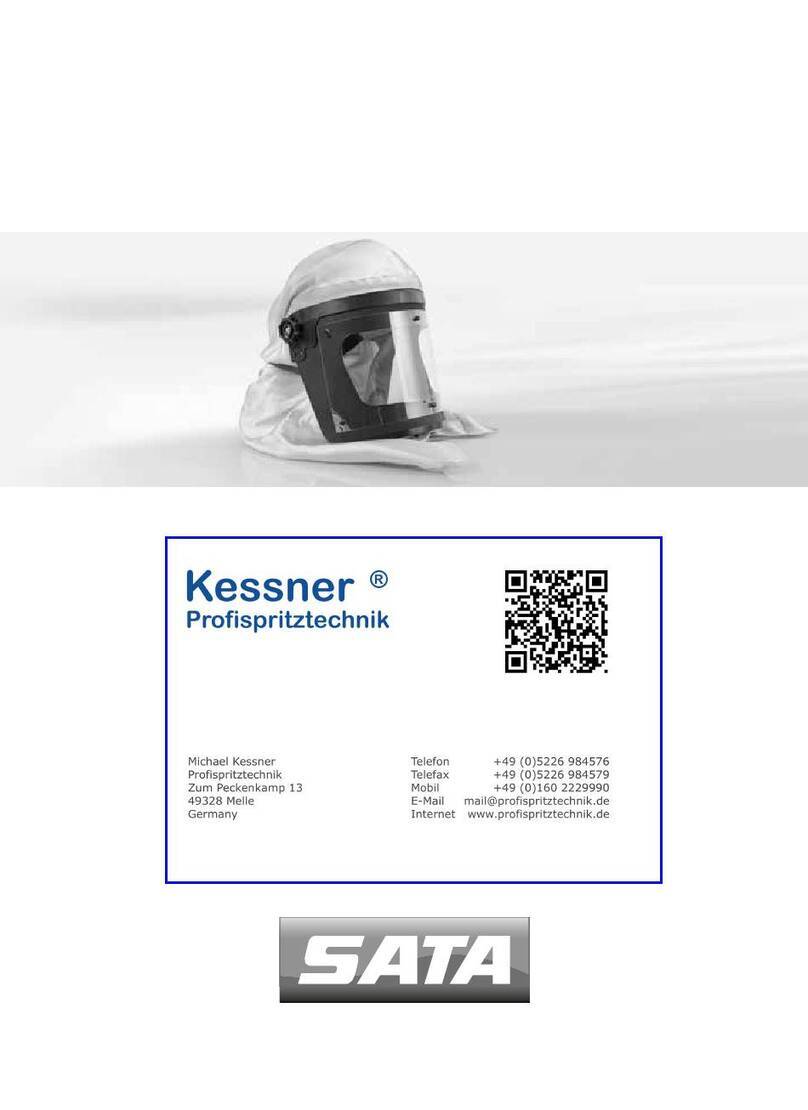
6
SR 580 Helmet
• Helmetwithlowervisorframe,visorandfaceseal
• Breathinghose
• Userinstructions
• Cleaningtissue
3.3 Assembly
See also the User Instructions for SR 500 Powered Air-Purifying
Respirator. Do not attempt to assemble or use the SR 500
PAPR without reviewing and understanding the SR 500
PAPR User Instructions. Refer to the NIOSH Approval Label
for approved configuration of components, cautions, and
limitation statements. The NIOSH Approval Label is an insert
provided with the SR 500 PAPR fan unit User Instructions.
Additional copies of the NIOSH Approval Label may be
obtained by contacting Sundström in the U.S.A. and Canada
at 1- 877- SUNDSTROM.
SR 520 and SR 530 Hoods with Breathing Hose (Fig. 1)
No assembly is required for attaching the breathing hose to the
SR 520 and SR 530 hoods. The SR 520 and SR 530 hoods
have the breathing hose attached by Sundström.
SR 540 Face Shield (Fig. 2)
Breathing Hose
One end of the breathing hose is provided with a flat gasket
(Fig. 4a) and the other with an O-ring (Fig. 4b). Connect the end
with the gasket to the SR 540 Face Shield and the end with the
O-ring to the SR 500 PAPR Fan Unit.
SR 580 Helmet (Fig. 3)
Breathing hose
One end of the hose has a ø 42 mm thread (Fig. 3b), whilst the
other is fitted with an O-ring (Fig. 3c). The threaded end is to be
connected to the SR 580 Helmet and the end with the O-ring
to the SR 500 PAPR Fan Unit.
4. User Training and Operating
Instructions
4.1 Respirator Selection and Training
A written respiratory protection program must be implemented
for occupational use of the SR 500 Powered Air-Purifying Res-
pirator meeting all the requirements of OSHA 29 CFR 1910.134
such as records keeping, training, fit testing, medical evalua-
tion, and applicable OSHA substance specific standards. In
Canada, CSA standards Z94.4 requirements must be met and/
or requirements of the applicable jurisdiction, as appropriate.
Before use, the employer must assure that each respirator user
has been trained by a qualified person in the proper use and
maintenance of the respirator according to the instructions
contained in these User Instructions and other applicable User
Instructions (e.g. SR 500 PAPR, cartridges, filter, etc.).
Use of the SR 500 Powered Air-Purifying Respirator must be
in accordance with applicable health and safety standards,
respirator selection tables contained in such publications as
American National Standards Institute (ANSI) Z88.2-1992 or
the Canadian Standards Association (CSA) Standard Z94.4.
4.2 NIOSH Approval Label
For a listing of the components of the NIOSH approved SR 500
Powered Air-Purifying Respirator system using the SR 520/
SR 530 Hoods, SR 540 Face Shield and SR 580 Helmet refer
to the NIOSH Approval Label, which is an insert to the SR
500 PAPR User Instructions. The NIOSH Approval label also
contains the NIOSH cautions and limitations. For additional
copies contact Sundström in the U.S.A. and Canada at
1- 877- SUNDSTROM.
4.3 Donning (putting the hood, face shield
or helmet on)
See also the User Instructions for SR 500 Powered Air-Purifying
Respirator.
SR 520
• AdjusttheheadharnessbyadjustingthelengthoftheVelcro
strap. This is important for ensuring a good fit. Fig. 5.
• Gripthehosemountingwithonehandand,withtheother,
hold the strap in the lower part of the hood. Fig. 6.
• Putyourchinintothehood.Fig.7.
• Keepholdofthestrapandpullthehoodoveryourheadwith
the hand holding the hose mounting.
• Adjustthehoodsothatitsealsallthewayroundyourface
and so that it fits firmly and comfortably. Fig. 8.
• Toensureaperfectfit,itmaybenecessarytotakeoffthe
hood and adjust the head harness.
• Makesurethatthebreathinghoserunsalongyourbackand
is not twisted. Fig. 9.
SR 530
• AdjusttheheadharnessbyadjustingthelengthoftheVelcro
strap. Fig. 5.
• Holdthehoodupsidedown.Gripeachsideofthehood
opening with one hand. Fig. 10.
• Inonemovement,putyourchininandthentherestofyour
head into the hood. Fig. 11.
• Withthesamegrip,pullthehooddownsothatthehead
arness fits firmly and comfortably around your head.
• Adjustthenecksizeofthehoodbymeansoftheelastic
neck strap. Fig. 12.
• Abendablemetalrailisfittedaroundtheloweredgeofthe
visor. The distance between your face and the visor can be
adjusted by bending the rail by hand. Fig. 13.
• Makesurethatthebreathinghoserunsalongyourbackand
is not twisted. Fig. 9.
SR 540
• Raisethevisorandputthefaceshieldon.Fig.14.
• Ifnecessary,adjusttheheadharnessinheightbylengthen-
ing or shortening the strap for the top of the head. Fig. 15a.
• Ifnecessary,adjustthecircumferenceoftheheadharness
by means of the knob at the rear of the head harness. Fig.
15b.
• Lowerthevisorunitbypullingthefacesealdownunderyour
chin. A clicking sound indicates that the visor unit has been
lowered fully. Fig. 16.
• Insertafingerbetweenyourchinandthefacesealandrun
the finger along the contact surface of the face seal all the
way round to check that it fits well against the face. Fig. 17.
• Checkthatthebreathinghoserunsalongyourbackandit
is not twisted. Fig. 9.
SR 580
• Checkthatthe6-pointharnessissecuredcorrectly(Fig.
39).
• Raisethevisorandputonthehelmet(Fig.40).
• Ifnecessary,adjustthewidthofthehelmetusingtheknob
located at the rear of the harness (Fig. 41).
• Toadjusttheheightofthehelmetinterior,movethepins
between positions a and b (Fig. 42). If the interior is attached
to pin a, the helmet will sit lower, and on pin b the helmet
will be higher. To achieve the best fit, this adjustment can
be made at both the front and back of the helmet.
• Lowerthevisorbypullingthefacesealdownbelowyour
chin. A ‘click’ indicates that the visor is fully lowered (Fig.
43).
• Insertafingerinsidethefacesealandmoveitalongthe
length of the contact surface to check the fit (Fig. 44).
